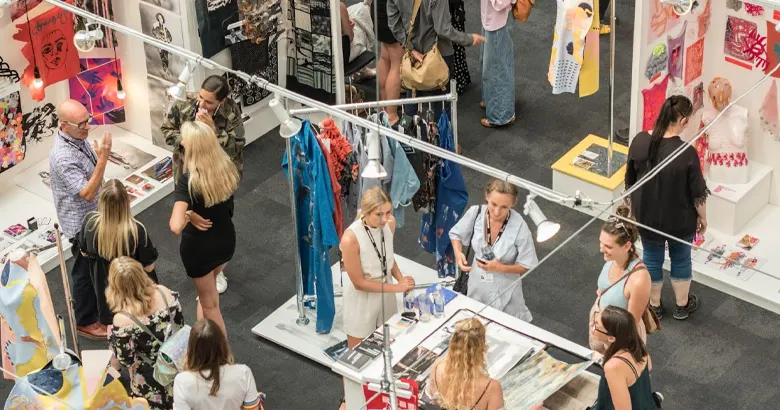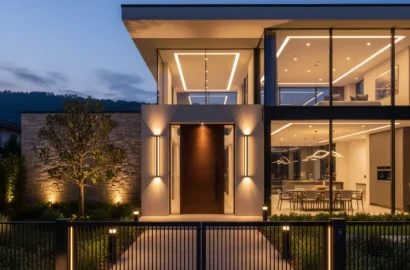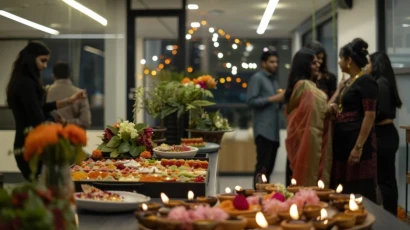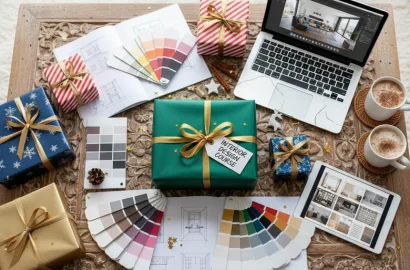Interested in exhibition design? Explore its significance, principles, types, and latest trends, and find out how to pursue a career in this field.
Exhibition design is an interdisciplinary field that conveys information and ideas through visually immersive environments. It’s about crafting experiences that inform, entertain, and inspire, using storytelling as the foundation. This discipline integrates aspects of communication, design, and fabrication, and requires expertise in spatial planning, image creation, narrative development, lighting design, interactive media, and scenography.
Exhibition designers also need a solid understanding of structures, typography, and visual design principles, along with insight into human behavior and perception.
In this comprehensive guide, we will delve into the principles and various types of exhibition design. We’ll also cover the fundamentals of color theory and take you through the latest trends shaping the field.
Here’s a clickable link to everything we’ll cover in this article!
- What is exhibition design?
- Principles of exhibition design
- Types of exhibition design
- Color theory in exhibition design
- Latest trends to look out for in exhibition design
- How to become an exhibition designer
- Conclusion and next steps
What is exhibition design?
Exhibition design is derived from extensive research on how we process visual information in complex environments. It aims to create more engaging and immersive spaces.
Studies reveal that our attention isn’t distributed evenly when we enter a space. It tends to follow patterns influenced by movement, contrast, and the relationships between objects within the space.
The main objective of exhibition design is to convey information through visual storytelling within thoughtfully curated spaces. It combines various disciplines, including interior design, graphic design, architecture, interaction design, multimedia, lighting, and audio. While doing so, it brings together various disciplines like interior design, graphic design, architecture, interaction design, multimedia, lighting, and audio, all of which work together to ensure that people understand and connect with the information being presented.
Exhibition design is a dynamic and collaborative process that requires balancing layout, objects, and information while skillfully incorporating technology to create an extraordinary experience for the audience.
Why is it important?
Exhibition design, with its focus on visuals and experiences, ensures that interactions are always meaningful. Whether for businesses or cultural events, effective exhibition design creates an environment where communication flows effortlessly, bridging gaps and making connections that wouldn’t be possible through other forms of interaction.
Exhibition design is important for organizations and start-ups looking to showcase their products, engage with potential customers, and build connections with industry peers. A well-designed exhibition space helps a company stand out from the competition and leave a lasting impression by reinforcing its brand and values.
Here’s why it matters:
1. Increased recall—People who attend exhibitions are more likely to remember what they have seen and experienced. It encourages people to spread the word about your products or services to friends and family. This makes it easier for you to follow up with potential customers through emails, reminding them about your brand and encouraging them to engage further.
2. Showcasing benefits—Exhibition design helps highlight the benefits of your product or service in a way that’s easy for visitors to understand. By presenting your product thoughtfully, you can make it clear how it will solve problems or improve the lives of your customers.
3. Creating excitement—A well-designed exhibition space can generate excitement around new products or services. This excitement helps boost brand awareness and recognition, which is essential for getting people interested and, ultimately, driving sales.

Principles of exhibition design
Exhibition design applies psychological insights to determine the placement of exhibits and guide visitors through exhibition spaces. By understanding how people react and interact, you can create environments that encourage meaningful engagement with the displays. These principles work not only for museums and galleries but also for businesses that occasionally host exhibitions in offices or public spaces to build brand awareness. Let’s take a look at them individually and understand how they can be used to design effective environments:
1. Vista approach
The Vista approach is a design strategy to direct visitors through planned viewing angles and focal points. Placing eye-catching pieces at the end of a hallway or gallery naturally draws people in, encouraging them to explore further. This method leverages curiosity, leading visitors to new discoveries as they move through the exhibition.
A sense of anticipation takes visitors to new viewpoints, gradually showcasing exquisite artwork or displays, eventually revealing the central theme of the exhibition. When using this approach, it is essential to consider factors such as the scale of the artwork, lighting, and the arrangements of partitions or walls. Large displays are often used as visual anchors, while strategic lighting highlights smaller pieces and creates depth.
2. Cognitive load management
Cognitive load theory focuses on how much new information our brains can process when exposed to new environments. In exhibition design, it refers to the mental effort required to understand and engage with what’s displayed. If the cognitive load is too high, visitors may feel overwhelmed and experience difficulty retaining information.
To manage cognitive load and ensure that visitors can absorb and reflect upon their experiences, you need to consider the following:
- The number of works displayed—Too many can overwhelm visitors, while too little may not provide enough engagement.
- Flow of information—The way information is distributed throughout the space.
- Information density—The complexity and volume of text, labels, and content.
- Using negative space—Areas with minimal visual interest that allow for mental rest and reflection.
- Quiet spaces—Areas with minimal distractions that give a break from information-dense sections and allow visitors to process what they’ve seen. Here, visitors get to focus on one piece at a time.
3. Co-visibility
Co-visibility refers to how exhibits are displayed in relation to each other, allowing viewers to observe multiple pieces at once and compare them. This approach helps highlight similarities or contrasts in style, theme, or technique. High co-visibility is ideal for showcasing a series of works, illustrating how something has evolved over time, or grouping works by theme. On the other hand, low co-visibility works best when you want to create a more intimate experience where each piece stands out on its own without distractions.
When designing for co-visibility, pay attention to factors like sightlines, lighting, and physical barriers. For high co-visibility, you may use open layouts and consistent lighting, whereas for low co-visibility, you can create more secluded spaces with focused lighting to allow each piece to shine individually.
Types of exhibition design

Image Courtesy: Uni.xyz
After covering the principles of exhibition design, let’s move on to its various types.
1. Museum exhibition
Museums have a remarkable ability to both educate and inspire. To create a successful and informative exhibition, it’s important to allow visitors to engage with the displays through interactive and multimedia features that enrich the learning experience. Select a theme that appeals to your target audience to attract and hold their interest. Consider incorporating augmented reality, virtual reality, or touchscreen displays to make your exhibition design more interactive and immersive.
2. Trade shows
Trade shows focus on networking, displaying products at booths, and creating immersive experiences for attendees. Select exhibits that resonate with your business objectives and target audience—this thoughtful selection can significantly improve the overall experience. Also, design exhibition booths that spark visual interest and allow visitors to interact. Use multimedia and technology to further engage visitors on various levels.

3. Themed festivals
Themed festivals offer an excellent opportunity to create memorable and one-of-a-kind exhibition designs that capture your audience’s attention. Elements like decorations, lighting, and music largely contribute to setting the mood of festivals. Create an environment incorporating unique experiences and games that fit the theme and also surprise and entertain your attendees. Additionally, if you have an outdoor festival, always use durable materials that can withstand various weather conditions while complementing the natural surroundings.
Color theory in exhibition design
Color theory plays a major role in how people interpret and experience an exhibition space. Read on for the various ways how this happens.
Color psychologically affects how people experience their surroundings, influencing their perception of time, space, and temperature. In commercial spaces, the choice of color in artwork can set the mood and influence the behavior of customers, visitors, and employees.
For example, cool colors like blues and greens create a calming atmosphere, making them ideal for spaces like break rooms where people go to relax. On the other hand, warm colors such as reds and oranges convey energy and activeness, making them perfect for retail environments or areas where businesses want customers to stay longer and engage with products.
Colors also have cultural meanings, which businesses must consider, especially in multicultural settings. The symbolism of color is not the same everywhere. Businesses with diverse customer bases need to ensure that the colors in their artwork don’t unintentionally communicate the wrong message to different groups.
For instance, white may symbolize purity in Western cultures, but in some Eastern cultures, it represents mourning. Similarly, red may signify luck in Chinese culture but can mean danger in many Western societies.
It’s also essential to think about how colors interact with each other.
For example, a green-toned artwork might stand out more against a red wall due to the contrast between the two colors. If placed on a green wall, it might blend in more subtly.
Lastly, choosing the right artwork is not just about picking individual pieces but also about how they complement the existing color scheme of the space. This approach also applies to product displays, marketing materials, and digital designs.

Latest trends to look out for in exhibition design
With technological advances and consumer behavior changing, it has become imperative to understand how to make the right impression on your target audience. Staying up-to-date with the latest trends can help you connect better and eventually grow in your industry. Here’s a rundown of the latest trends you should be aware of in 2025.
1. User-centric approach
Exhibiting is no longer limited to having impressive booth designs—it’s also about customer experience. Keep in mind that you need to connect with your audience on an emotional level to build a rapport. Every aspect of your exhibition design should be intuitive and aligned with a clear goal, effectively communicating the value of your products and services to potential customers.
Also, do not skip leveraging new tools and resources to take this experience to a whole new level this upcoming year.
2. Multi-sensory experiences
Engaging all five senses—sight, sound, touch, taste, and smell- is a powerful way to create lasting impressions among exhibition attendees. Today, exhibition booths provide a lot more than just visual and auditory engagement. They aim to incorporate distinctive lighting, interactive displays, touch panels, soothing background music, gamification, and pleasant aromas that appeal to multi-sensory experiences, helping your target audience connect with your brand.
Also, offering live demos at your stalls allows visitors to experience your product firsthand, creating a wholesome experience for your brand. You can also incorporate VR technology to showcase products that can be tried on and services that have a visual element to them.
3. The Un-booth concept
The days of traditional four-corner exhibition stand with basic graphics are long gone. Today, exhibitors are capturing their audience’s attention with innovative exhibition booth concepts. Some of the most successful ideas include features like food or bar counters for visitors to relax, charging stations for phones, and comfortable lounge areas where attendees can unwind. These spaces not only draw people in but also create the perfect setting for your booth staff to engage with potential clients.
Such concepts help create a more comfortable and mesmerizing experience for visitors. Along with thoughtful booth design, you should also update your graphics to stand out from the competition and consider incorporating monochrome designs, 3D depth, and realistic visuals to elevate the impact of your display.
4. Advanced technology
Technology’s integration into the exhibition industry has taken customer experiences to new heights, and its influence continues to expand. Artificial Intelligence (AI) and Virtual Reality (VR) hold unparalleled potential to engage customers in meaningful ways.
AI is reshaping how exhibitions operate globally, from virtual sales assistants and chatbots to advanced security features like image and speech recognition. Another exciting development is beacon technology, which uses small, low-cost devices to wirelessly transmit signals or data to nearby mobile devices with compatible apps. These advanced technologies are rapidly becoming defining trends in the exhibition industry, driving it forward with increased innovation and deeper audience engagement.
5. Social media
Many exhibitors overlook the power of social media during their events, missing out on a valuable opportunity. Social media connects clients, prospects, and partners, enabling messages to be shared quickly with a global audience.
It’s not just a communication tool for exhibitors but also for event organizers who can use it to share helpful content. With platforms like Facebook and Instagram offering live streaming features, the potential for exhibitors to engage in real-time is vast. To make the most of social media, ensure that your content aligns with your brand story, making it both engaging and relevant.

How to become an exhibition designer?
Now that we’ve covered many, if not all, aspects of exhibition design, let’s understand the step-by-step process for making a career in exhibition design.
1. Get a relevant degree
While it may not be mandatory, most reputed employers highly prefer a bachelor’s degree or a certificate course in fields like graphic design, interior design, architecture, spatial design, visual communication, or museum studies, which in some way may be related to exhibition design. These in-depth programs teach foundational design principles and skills, which can be beneficial while working as an exhibition designer.
2. Enroll in an internship or volunteering program
Gaining hands-on experience through internships or volunteer roles can be a great way to start and help build a strong work portfolio. These opportunities allow you to understand the workings of various institutions and give you practical experience in the field. This could include working at an exhibition design firm, for museums, galleries, trade show organizers, or as part of a corporate marketing team.
3. Learn about exhibition logistics
Exhibition design involves understanding the logistics of creating an exhibition space that includes spatial planning—understanding how to design layouts that enable smooth foot traffic while keeping the exhibits engaging, technical infrastructure—learning about wiring, AV equipment, and how exhibits are lit and displayed, and lastly budgeting and sourcing—learning to work alongside contractors within a budget and sourcing materials.
4. Understand client needs
Every exhibition has a different purpose: to inform, entertain, sell, or promote a cause. As an exhibition designer, it’s crucial to understand the client’s objectives:
- Concept Development: Work with the client to define the vision of the exhibition, including the theme, audience, and desired outcomes.
- Storytelling: Craft a narrative within the exhibition that engages visitors and communicates the intended message clearly.
5. Pursue a Master’s Degree
Albeit optional, a master’s degree in a relevant field like design or art history can give you an edge in the competitive job market. It offers more profound knowledge and helps you stand out from other candidates.
Conclusion and next steps
As we’ve discussed, designing exhibition spaces with your target audience in mind ensures that your space is not only visually appealing but also offers a wholesome experience. When integrating the latest trends into your event, it’s essential to first evaluate your exhibition’s objectives, audience, and industry. Choose the trends that align best with your goals and have the potential to make a lasting impact on your customers.
If you enjoyed this article and would like to learn more about interior design, head back to AND Academy’s blog for more articles like this one. We also recommend you check out this project by AND Learner, Sonali Khajuria to get inspiration for your next interior design project.
In case you need further assistance, here are some resources to consider:
- Watch this session by Snehanshu Mukherjee, Founding Partner at T.E.A.M and Mansi Almadi, an Interior Designer at Studio Lotus
- Talk to a course advisor to discuss how you can transform your career with one of our courses.
- Check out our Interior Design courses – all courses are taught through live, interactive classes by industry experts.
- Take advantage of our scholarship and funding options to overcome any financial hurdle on the path of your career transformation.
Note: All information and/or data from external sources is believed to be accurate as of the date of publication.









